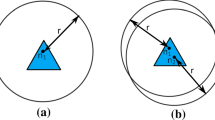Abstract
Area coverage is one of the fundamental problems in wireless sensor networks. The main objective is to minimize the number of active sensors to conserve energy consumption, while complete area coverage is achieved. Some of the existing solutions are based on the location information of sensors which are not applicable to scenarios where GPS modules are not available and there is no reliable location information of sensors. In this paper, we present a distributed homological sensor selection algorithm, namely DHSS, to select the least number of sensors to cover the entire area in the case that no location information is available. We consider the Rips complex of the network and formulate the selection problem as an optimization problem. DHSS tries to find the least number of 2-simplices of the Rips complex of the network to cover the entire area in a distributed manner. Finally, we evaluate the performance of the proposed algorithm by conducting simulation experiments.






Similar content being viewed by others
References
Ding, Y.-S., Lu, X.-J., Hao, K.-R., Li, L.-F., & Hu, Y.-F. (2011). Target coverage optimisation of wireless sensor networks using a multi-objective immune co-evolutionary algorithm. International Journal of Systems Science, 42(9), 1531–1541. doi:10.1080/00207721.2011.564328.
Zhang, Q., Zhang, C., Liu, M., & Zhang, S. (2014). Local node selection for target tracking based on underwater wireless sensor networks. International Journal of Systems Science. doi:10.1080/00207721.2014.880199.
Joon-Hong, S., Joon-Yong, L., Won, K., & Ju-Jang, L. (2013). A bipopulation-based evolutionary algorithm for solving full area coverage problems. Sensors Journal, IEEE, 13(12), 4796–4807. doi:10.1109/jsen.2013.2274693.
Ghosh, A., & Das, S. K. (2008). Coverage and connectivity issues in wireless sensor networks: A survey. Pervasive and Mobile Computing, 4(3), 303–334. doi:10.1016/j.pmcj.2008.02.001.
Zhu, C., Zheng, C., Shu, L., & Han, G. (2012). A survey on coverage and connectivity issues in wireless sensor networks. Journal of Network and Computer Applications, 35(2), 619–632. doi:10.1016/j.jnca.2011.11.016.
Ghrist, R., & Muhammad, A. (2005). Coverage and hole-detection in sensor networks via homology. In Proceedings of the 4th international symposium on Information processing in sensor networks, Los Angeles, California (pp. 254–260). 1147729: IEEE Press.
de Silva, V., & Ghrist, R. (2007). Coverage in sensor networks via persistent homology. Algebraic Geometry and Topology, 7, 339–358.
Silva, V. D., & Ghrist, R. (2006). Coordinate-free coverage in sensor networks with controlled boundaries via homology. International Journal of Robotics Research, 25(12), 1205–1222. doi:10.1177/0278364906072252.
Varposhti, M., Dehghan, M., & Safabakhsh, R. (2014). Distributed topological camera selection without location information. Sensors Journal, IEEE, 14(8), 2579–2589. doi:10.1109/jsen.2014.2309797.
Lobaton, E., Vasudevan, R., Bajcsy, R., & Sastry, S. (2010). A distributed topological camera network representation for tracking applications. IEEE Transaction on Image Processing, 19(10), 2516–2529. doi:10.1109/tip.2010.2052273.
Muhammad, A., & Jadbabaie, A. (2007). Decentralized computation of homology groups in networks by gossip. In American Control Conference, ACC ‘07, 9-13 July 2007 (pp. 3438–3443).
Muhammad, A., & Egerstedt, M. (2006). Control using higher order Laplacians in network topologies. In Proceedings of the 17th International Symposium on Mathematical Theory of Networks and Systems, Kyoto, Japan (pp. 1024–1038).
Tahbaz-Salehi, A., & Jadbabaie, A. (2010). Distributed coverage verification in sensor networks without location information. IEEE Transactions on Automatic Control, 55(8), 1837–1849.
Varposhti, M., Dehghan, M., & Safabakhsh, R. (2012). Camera selection without location information: A topological approach. In IEEE Symposium on Computers and Communications, ISCC’12, Cappadocia, Turkey (pp. 376–381): IEEE.
Osais, Y., St-Hilaire, M., & Yu, F. (2008). The minimum cost sensor placement problem for directional wireless sensor networks. In IEEE Intl. Conference on Vehicular Technology (VTC’08), Calgary, Canada (pp. 1–5).
Nath, S., & Gibbons, P. B. (2007). Communicating via fireflies: geographic routing on duty-cycled sensors. In Proceedings of the 6th international conference on Information processing in sensor networks, Cambridge, Massachusetts, USA (pp. 440–449). 1236416: ACM. doi:10.1145/1236360.1236416.
Wang, B., Fu, C., & Lim, H. B. (2009). Layered diffusion-based coverage control in wireless sensor networks. Computer Networks, 53(7), 1114–1124. doi:10.1016/j.comnet.2008.12.013.
Zhang, H., & Hou, J. (2005). Maintaining sensing coverage and connectivity in large sensor networks. Ad Hoc & Sensor Wireless Networks, 1(1–2), 89–124.
Meguerdichian, S., Koushanfar, F., Potkonjak, M., & Srivastava, M. B. (2001). Coverage problems in wireless ad-hoc sensor networks. In INFOCOM 2001. Twentieth Annual Joint Conference of the IEEE Computer and Communications Societies. Proceedings. IEEE (Vol. 3, pp. 1380–1387). doi:10.1109/infcom.2001.916633.
Li, X.-Y., Wan, P.-J., & Frieder, O. (2003). Coverage in wireless ad-hoc sensor networks. IEEE Transactions on Computers, 52(6), 753–763.
Hörster, E., & Lienhart, R. (2009). Optimal placement of multiple visual sensors. In H. Aghajan & A. Cavallaro (Eds.), Multi-camera networks: Concepts and applications. New York: Academic Press.
Zou, Y., & Chakrabarty, K. (2003). Sensor deployment and target localization based on virtual forces. In Twenty-Second Annual Joint Conference of the IEEE Computer and Communications, INFOCOM 2003, 30 March-3 April 2003 (Vol. 2, pp. 1293–1303).
Hatcher, A. (2002). Algebraic topology. Cambridge: Cambridge University Press.
Croom, F. H. (1978). Basic concepts of algebraic topology. Berlin: Springer.
Bott, R., & Tu, L. (1995). Differential forms in algebraic topology. New York: Springer.
de Silva, V., & Ghrist, R. (2006). Coordinate-free coverage in sensor networks with controlled boundaries via homology. The International Journal of Robotics Research, 25(12), 1205–1222. doi:10.1177/0278364906072252.
Wang, J., Niu, C., & Shen, R. (2009). Priority-based target coverage in directional sensor networks using a genetic algorithm. Computers & Mathematics with Applications, 57(11–12), 1915–1922.
Author information
Authors and Affiliations
Corresponding author
Rights and permissions
About this article
Cite this article
Varposhti, M., Dehghan, M. & Safabakhsh, R. A Distributed Homological Approach to Location-Independent Area Coverage in Wireless Sensor Networks. Wireless Pers Commun 83, 3075–3089 (2015). https://doi.org/10.1007/s11277-015-2583-z
Published:
Issue Date:
DOI: https://doi.org/10.1007/s11277-015-2583-z




